#duke knightly
Text

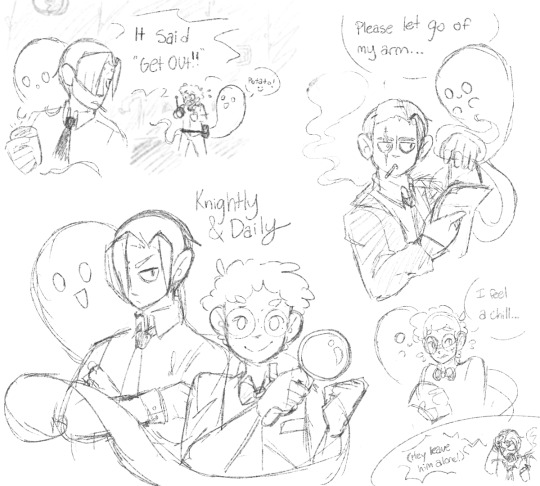
Some OC doobles
#love these boys#jaded old man and his emotional support apprentice#duke knightly#andy daily#ocs#my ocs#tw:#scars#ghost#smoke#my art#doodles#sketches
8 notes
·
View notes
Text

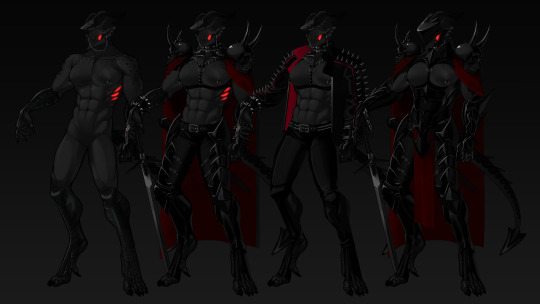
Vail - The Unsung Duke, Leader of a Knightly Legion and Guardian of the Resilient.
#Dark-kanova#demon#original character#oc#monster#knight#more rough style here just to give myself a break. Still put some polish on it though#Artists on tumblr#Alt text in image
420 notes
·
View notes
Note
wait how bougie was Tom Riddle Sr.? How nice would his Manor have been? Was he like an actually Lord with a title and stuff?
thank you very much for the ask, anon!
in half-blood prince, dumbledore refers to tom riddle sr. as "the squire's son" - which allows us to state with certainty that he was a minor aristocrat.
however, the word minor is important here.
there are - historically - two levels of aristocracy in britain. the first are the peers of the realm - which refers to families which hold one or more of the titles of duke, marquess, earl, or viscount. these are the elite of the elite - these gradations of nobility were created in the middle ages as a way of distinguishing those who held the titles from other noblemen, usually because of a close relationship [often one of blood or marriage or both] to the king.
the titles are hereditary by male primogeniture, and the holders - while this is no longer the case - used to have political power [such as the right to sit in the house of lords], simply by virtue of their birth.
[this is why they're called "peers" - it refers to them historically being close in status to royalty, and therefore expected to serve as royal advisors.]
there is another class of peer - a baronet - whose title is similarly hereditary, but whose position doesn't come historically with the right to sit in the lords or advise the king by virtue of birth. [baronets may - of course - have been members of parliament, or royal advisors selected at the king's discretion, but this would be separate from their title. a duke, in contrast, could historically expect to request a meeting with the king simply because he was a duke.]
while some families have historically been ennobled at the king's discretion, access to any of these titles is pretty much restricted to the small group of families who've held them for centuries.
but below the peers of the realm, there is a second, more minor class of aristocracy, the landed gentry - of which a village squire is a textbook example.
historically, what is meant by "landed" is an ability to live off of the rental income of one's country holdings, which would be leased to tenant farmers. that is, they are landlords in the original sense of the term - lords of the land. this is what tom sr. tells us his family does in half-blood prince:
“It’s not ours,” said a young man’s voice. “Everything on the other side of the valley belongs to us, but that cottage belongs to an old tramp called Gaunt, and his children. The son’s quite mad, you should hear some of the stories they tell in the village - ”
what is also meant by "landed" is that the family in question is of the upper-classes, but that they are still "commoners" - which in this context doesn't imply a value judgement, but which is a socio-legal term which simply indicates that they don't hold an aristocratic title such as duke, earl etc.
[and gentry families certainly aren't common in terms of financial standing... the most famous member of this class in literature? fitzwilliam darcy, whose ten thousand a year is something like thirteen million quid in today's money...]
gentry families might be very old - they might have received their lands from the king in the middle ages as a reward for knightly service, and it's interesting to imagine generations of gaunts and riddles brought up alongside each other in little hangleton - or they might be comparatively newer - tom sr.'s great-grandfather [feasibly born c.1810] could have been a self-made victorian industrialist who bought the lands from the original holder and established himself as gentry.
by 1900, it was becoming much harder for the gentry to live on rental income alone, and many would also have had jobs. these would have been elite, and very frequently were in politics, the civil service, the military, or the law. tom sr's father - whom the films call thomas, so let's go with that - might, for example, have served as a high-ranking officer in the army [including during the first world war], be the local magistrate, or be the local member of parliament.
in terms of titles, thomas riddle would almost undoubtedly be sir thomas - and this is how it would be correct to address him. but this title would be a courtesy, and it wouldn't be hereditary unless the riddles were also baronets [which it's entirely plausible that they were].
which is to say, tom sr. would not have a title while his father was alive - although he would have the right to be referred to formally in writing as mr thomas riddle esq. [esquire]. the correct form of verbal address for anyone other than friends and family would be to call him mr riddle, although the riddles' servants would probably refer to him as mister tom.
tom jr. would not have a title while his father or grandfather was alive. if the riddles were baronets, he would technically inherit the title after he kills the rest of the male line... but given that tom sr. never acknowledged him and his existence was presumably unknown to the riddles' lawyers this wouldn't be something which happened in reality. the estate's executors clearly took control of the riddles' property, the land was portioned off and sold, and the house became a standalone property for sale.
the riddle house - which is a name used informally for it in little hangleton, it would have a different "proper" name - is described in canon in ways which show that it's a typical manor house, which means it would look something like this:
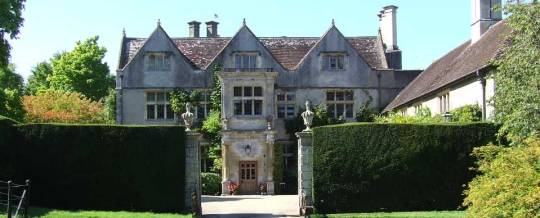
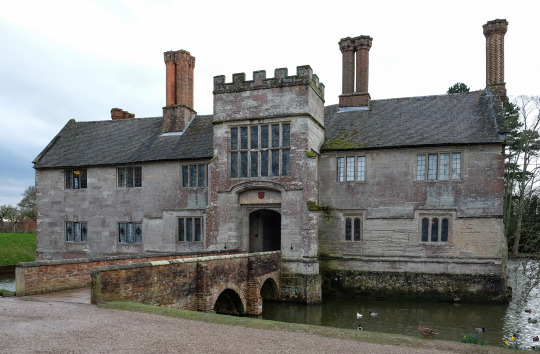
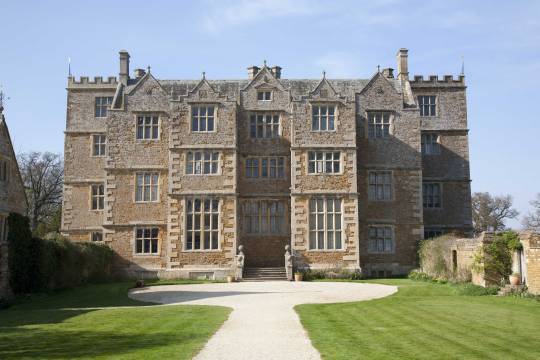

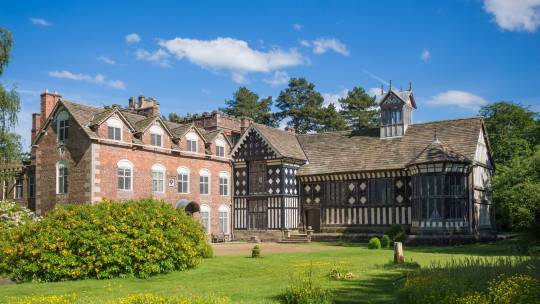
these houses are obviously very impressive, but they're tiny in size in comparison to the magnificent stately homes - places like blenheim palace, chatsworth, burghley house, holkham hall - lived in by the titled aristocracy. the riddles would entertain - for example - by giving house parties, dinner parties, hunting parties, etc., but they wouldn't have a ballroom or a dining hall capable of seating hundreds.
[they would probably also own a property - probably a flat or small house - in london.]
they would have servants, but not colossal numbers - they would undoubtedly have a butler but not footmen, and the upstairs maids would report to the butler since they probably wouldn't have a housekeeper. they canonically have a cook, who probably had one or two kitchen maids assisting, and they canonically have a gardener - frank bryce - who probably doesn't have any assistants. they may, depending on the size of the estate, have a gamekeeper. sir thomas undoubtedly had a secretary and a chauffeur, and his wife might have a lady's maid. tom sr. would have had a nanny and then been educated until at least the age of eight by a governess, but would then have attended a prep school [either day or boarding] until the age of thirteen, and then gone to a boarding school, from which he likely went on [on the basis of social class rather than talent] to oxford or cambridge.
the family would have enormous social influence locally. most people - and also businesses - in little hangleton would be their tenants, and they would also probably have a say over the appointment of the local clergyman [an important figure in the community in the nineteenth and early twentieth centuries], since the parish church is likely to have been something called a "living" - the thing which turns up again and again in jane austen - which means that the church and its parsonage technically belongs to the landowner, but is granted to the vicar as a freehold while he's in post.
gossip about the riddles' doings would also be the main source of local interest - the servants were dining out for months on tom sr.'s elopement and return.
so they're something resembling celebrities - but they're local celebrities. nobody in london - and even nobody in cities we can imagine are nearer to little hangleton, such as liverpool - would particularly know or care who they were. tom sr. might have made it into the london gossip columns if he was part of a particularly scandalous "set" [a group of friends] who socialised in the capital, but these mentions would have been fleeting - and the press would have been much more concerned by the doings of members of his set who were genuinely titled or who were legitimately famous.
[this is the reason why mrs cole doesn't recognise the name. if merope had said her son was to be named cecil beaton after his father, she may well have been prompted to hunt him down...]
so tom sr. is elite - but he's elite in a way which is extremely culturally-specific, and which is [just like the portrayal of aristocracy in the wizarding world - the blacks, for example, are far less aristocratic than the riddles in terms of canonical vibe] often exaggerated into the sort of pseudo-royal grand aristocracy which the british period-drama-industrial-complex makes such a big deal of.
and tom jr.'s character is affected by this in a series of extremely interesting ways.
by which i mean that, in terms of blood, he's probably the most aristocratic character in the series - the absence of grand aristocracy in the wizarding world would mean that [were he raised by his father] he would come from a social background which was equivalent [even as it was divided from them by virtue of being muggle] to any of his fellow slytherins, and would help him easily blend into their society because the manners, genre of socio-cultural reference points [he would recognise, for example, that quidditch heavily resembles both rugby and polo], accent and way of speaking etc. that he would possess would be broadly indistinguishable from those of his pureblood peers.
[this is why justin finch-fletchley and draco malfoy speak in essentially the same way.]
but he would then be given the enormous boost in cachet - one which would genuinely elevate him above the rest of his cohort - of his maternal line.
and we see in canon that this does bestow some privilege on him among his peers while he's in school:
Tom Riddle merely smiled as the others laughed again. Harry noticed that he was by no means the eldest of the group of boys, but that they all seemed to look to him as their leader.
“I don’t know that politics would suit me, sir,” he said when the laughter had died away. “I don’t have the right kind of background, for one thing.”
A couple of the boys around him smirked at each other. Harry was sure they were enjoying a private joke, undoubtedly about what they knew, or suspected, regarding their gang leader’s famous ancestor.
where he's let down socially is that people like slughorn - to whom he can't reveal his slytherin ancestry and hope to maintain cover for his wrongdoing - don't think he's come from anywhere particularly special. this is because he has a muggle father - absolutely - but it's even more that he has a muggle father who, since he left him to be raised in an orphanage, was presumably working-class.
what the young voldemort lacks is any socio-cultural familiarity with the muggle class performance which the class performance of the wizarding world parallels. abraxas malfoy boasting about how important his father is would be something a tom jr. raised by the riddles could match - "oh yes, my father gives to all sorts of causes too. in fact, he was invited to buckingham palace because of it." - establishing himself as an equal in terms of class and social influence even if he isn't an equal in blood.
what actually happens in canon is that the orphaned tom - with his uncouth manners and his working-class accent - has no hope of gaining any sort of social equality with his posh peers.
so he becomes determined to outrank - and humiliate and control - them.
#asks answered#asenora meta#tom riddle sr#tom riddle#lord voldemort#surprise! it's the class system!
89 notes
·
View notes
Text
Zelink gets Isekaied into BG3 Pt5: Let's Split Up, Gang!
Zelda- High Elf Draconic Lineage Sorcerer
Link- Half Wood Elf Champion Fighter
So far: Karlach has joined the party, Zelda has begun her infernal machinery research, and Karlach asks Link about his relationship with Zelda
When Zelda finally says goodbye to Dammon, she finds Link looking uncomfortable with Karlach and Astarion on either side of him. She asks what's wrong and Link takes the opportunity to escape and ask where they're going next.
Zelda is split between continuing to explore across the bridge and looking into Moonhaven more. Lae'zel suggests they split into two teams of four to explore both. Zelink is shaken by the suggestion, but can't deny the idea.
Team Link (Link, Wyll, Shadowheart, and Gale) will investigate Moonhaven.
Team Zelda (Zelda, Karlach, Lae'zel, and Astarion) will explore The Risen Road.
The teams will meet back up at camp (probably outside The Grove) at [time is a nebulous concept.]
As the group finishes distributing resources, Zelda hugs Link. She gives him a meaningful kiss goodbye before Team Zelda warps to their destination, leaving him stunned.
Link is mercifully left with the group least likely to hound him for information, but is still asked a few questions that he responds to with characteristic brevity before Team Link warps back to Moonhaven.
Karlach and Astarion ask Zelda about her and Link in their own ways as they walk and Zelda is much more open to answering than her boyfriend.
She tells them they've been living together since the end of the Calamity and started dating a year or so after that. Astarion asks about marriage and she gets bashful, saying they're waiting for the kingdom to get back on its feet. Lae'zel is watching the environment to try and distract herself from this inane dribble.
Lae'zel notices some movement up the road from where they dealt with the Gnolls. Evidently, there were even more Gnolls. Lae'zel advises Zelda to have herself and Karlach head straight in and let her and Astarion sneak up the small hill and give them support from the high ground. Zelda gives the thumbs up and Team Zelda makes short work of the Gnolls, though the moment is sullied when they find a pair of corpses in the cave. That Iron Flask they find is spooky.
Team Zelda continues and finds Waukeen's Rest on fire. Zelda immediately orders the party to search & rescue or join these nice knightly-looking people to put out the fires. She asks Karlach just how fireproof she is. Karlach enthusiastically says she can take a quick pop into an inferno if need be.
Astarion takes a bucket and heads into the less-enflamed buildings and does some light looting veiled as looking for survivors.
Lae'zel kicks down the front door and lets Karlach take the lead into the building. Zelda follows, hitting every blaze with Ray of Frost as she goes.
They get Florrick out, but Zelda hears someone yelling for help from a closed room. She recognizes that the room will ignite further if they open the door and she has Karlach bust in, find the guy, and get out before she blasts the room with a real big Ray of Frost (Ice Storm)
While Zelda goes around magically putting out fires, the rest of the team talks to Florrick and the Flaming Fist, getting the plot info (Astarion takes the lead.) Duke Ravengard, Moonrise Towers, etc.
During a short rest, the team fills Zelda in on what they've learned.
After their rest, they continue down the road and see the red dragon flying overhead. Lae'zel jogs ahead of the party to meet her fellow Gith.
The encounter begins as normal with Lae'zel taking the lead, but eventually, Voss' dragon takes an interest in Zelda. Zelda can feel that the dragon means her no harm and gently communes with it. This impresses Voss enough to believe Lae'zel's deception (or gives Lae'zel the confidence to convincingly lie) and the encounter ends without conflict.
With the knowledge that the Gith are searching for Shadowheart's artefact, Team Zelda decides to head back to camp for the time being.
#Baldur's Gate III#Baldur's Gate 3#BG3#Legend of Zelda#LoZ#Breath of the Wild#BotW#Tears of the Kingdom#TotK#Zelda#Link#Hero of the Wild#Shadowheart#Lae'zel#Astarion Ancunin#Gale Dekarios#Gale of Waterdeep#Wyll Ravengard#Karlach Cliffgate#Zelda x Link#Zelink
31 notes
·
View notes
Text
Arthurian Vocabulary in Old Yiddish (Pt. 2)
I've reread Vidvilt a few more times since I made my first vocabulary post earlier this year, and I realized I left quite a few relevant words off that list, so behold the sequel!
דש ברױאן צימר - female attendants
גינעדיג - gracious, merciful
דער דעגן - young man, hero
דער דעגן - dagger
דער הירץ - stag
דער העלד - hero
דער העלם - helmet
הערליך - noble, excellent
דער הערצוג - duke
דער װארום - dragon
ועכטן - swordplay
טוגנטליך - noble, virtuous
דער טורניר - tournament
טורנירן - to tourney
די מאנהײט - manliness, prowess, bravery
די מײט - maiden
דש מעגיטיין - maiden
דער צװערג - dwarf
דער צױברר - sorcerer
דער קװעל - well, fountain
דש קױנגרײך - kingdom
קײזרליך - imperial
דער קנאב - boy, youth
דער קנעכט - squire
דער ריז - giant
ריטרליך - knightly, chivalrous
שטולץ - proud
שטורמן - fighting
שטעכן - stabbing
דער שילט - shield
71 notes
·
View notes
Text
Moonbeam Duke (Reverse Robins)
Duke was... tough. There's not nearly as many differing designs to draw on for him, and frankly I don't like a whole lot of them. I do like the mainline Signal costumes I've seen (both the black symbol w/ full-face helmet, and the glowing symbol w/ jaw exposed) but they really have more "Independent Hero" vibes.
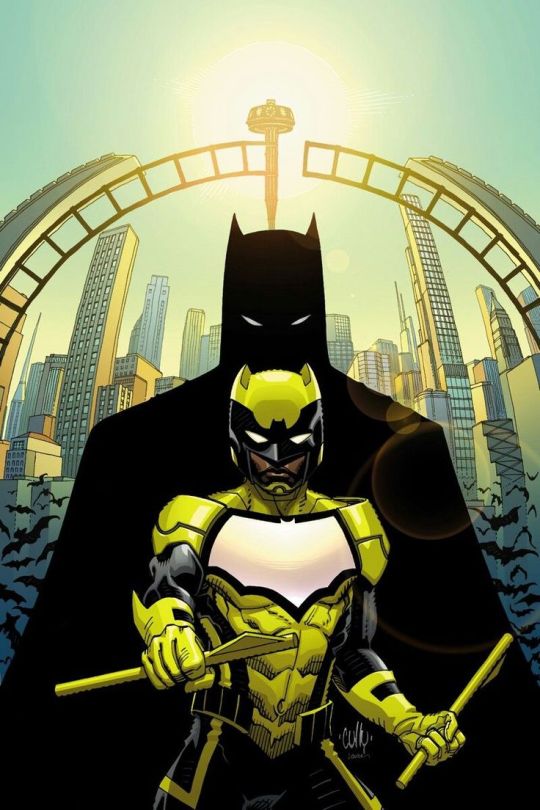


(These designs are all dope, but not great sidekick material.)
Digging through reference images led me to realize that even in his Elseworld appearances, Duke almost always gravitates towards those knightly vibes. Boy likes his armor with a little fantasy-flair.


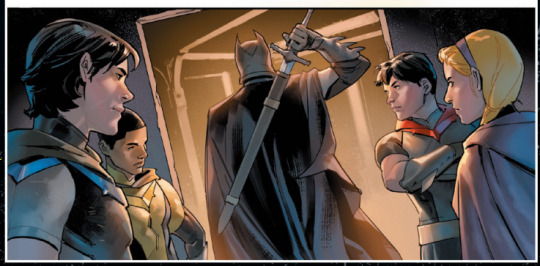


("Future's End" & "White Knight" a bit less so, but I still get cyberpunk-knight vibes from both—maybe it’s just me.)
Those that aren't all knightly tend to be stylized but durable street clothes, that are just out there enough to pass for a costume but could just as easily be worn by someone in their everyday life.

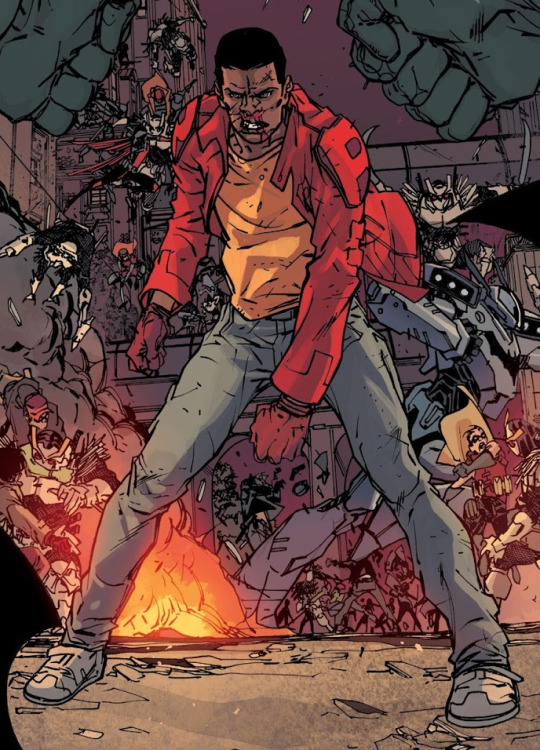
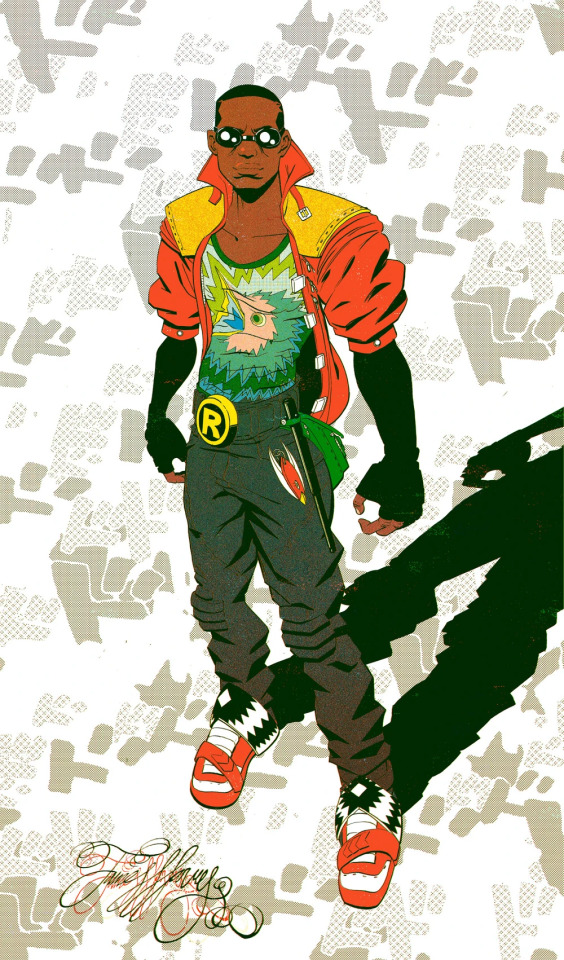

(Last one is this redesign by @sufroyo, but gods do I love it!)
Duke will probably want some of that knightly vibe, but Moonbeam is kinda my Robin figure in this AU; he needs to look like the less-experienced partner to Gotham’s Dark Knight, rather than a Knight in his own right. And I should combine that with his preference for practical, durable, almost-understated fashion.
So… streetwear-squire. Let's see what I can do.
First off, we can get both sets of vibes by starting with a gambeson as our base. Go for a shorter one to emphasize that jacket look, and while they come in a whole variety of styles, I think off-center clasps looks just a little bit more modern. I'd also say he doesn't buckle up his neck, giving it that popped-collar look Duke seems to like.

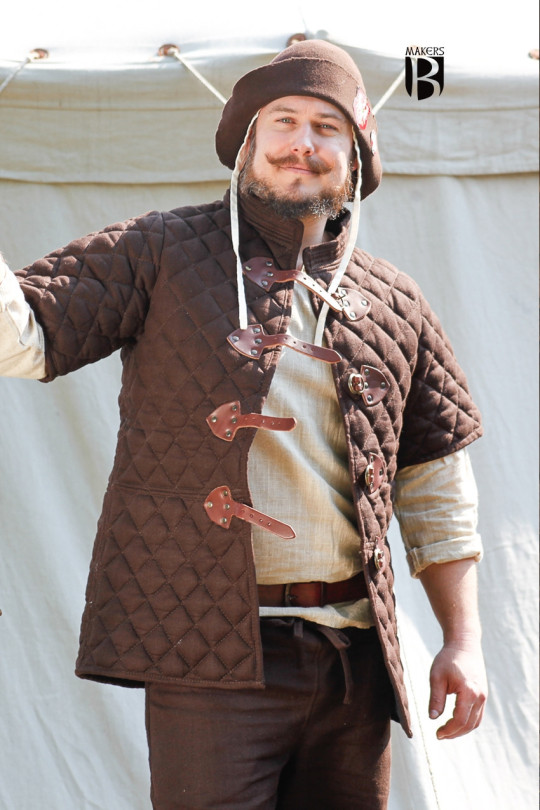
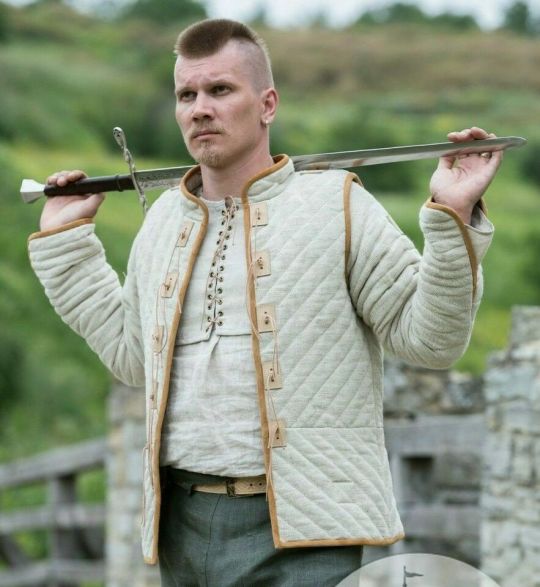

(Off-centered clasps, as well as a couple casually worn gambesons to show the kind of effect you can get. Duke's is definitely the kind that covers the hip to brush the top of the thigh, but given most people think of gambesons as being knee-length, that's still short.)
And, hell, if Robin can wear bright colors then so can Moonbeam. Using the "It'll help you learn to sneak better" excuse, Duke's gambeson is cream colored. (It also looks better contrasted to Batman's black.)
I like the idea of the gambeson having built-in gloves like in Duke's "Final Knight" costume, but I don't really like the look of Final Knight’s Duke design(s). Erm, any of them. I'd define the difference on the sleeves a little more by giving him hand & arm bracers to wear over the top, probably some simple pauldrons, and maybe a gradient on the arms from cream to grey.


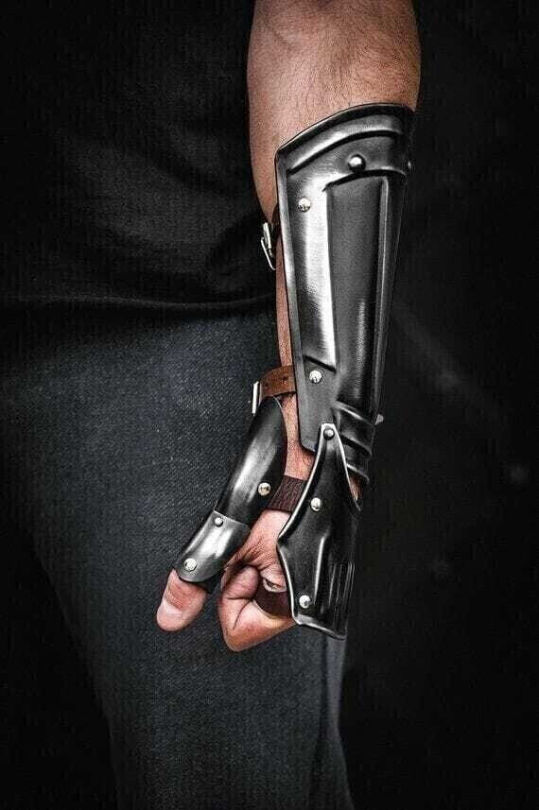
(Not 100% on the gradient, just think the fully light sleeve might not work even with the bracers. Keep the metal simple & understated, though, and remember the lines in the sleeves are from padded fabric rather than any kind of wrappings.)
Still, that's a long stretch of one pretty plain color. The main body needs to be broken up, and Duke should probably have a bit more protection, but we don't want to hamper his mobility. Let's add a demi-brestplate (also called a demi-cuirass or "heroic armor") on top. That protects the upper chest without going past the rib-cage, to avoid hampering movement.


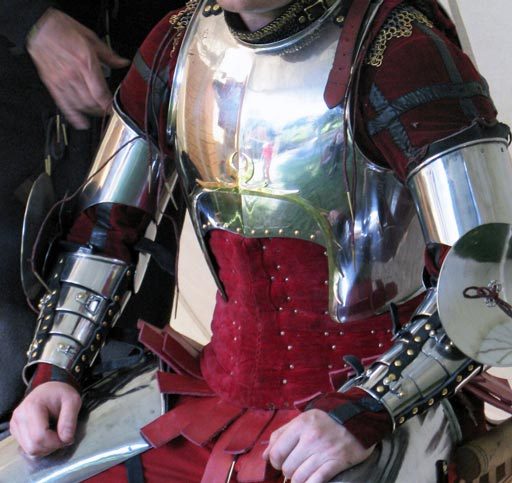
(I really, really like this fluted design, but can't find anything smiliar in a demi. I've also always liked the look of breastplates which are 2 pieces held together by straps under the arms. The last one is just to give you a better idea of the size/form of the thing.)
And a steel-grey utility belt, obviously.
(...I should probably mention, none of this metal should be highly-polished. It's not glinting like a mirror whenever Duke's not redirecting light away from him, it's just a step or two above matte-finishing.)
I'd say Duke's symbol is an iridescent/opalized circle right in the middle of his chest, representing a full moon (or the bat signal minus the bat.) So it looks white, but it shimmers rainbow when it catches the light. Probably has either a black or gold ring around it to help it stand out.


(A normal opal, and opalized glass with light shining through it. No, the ring does not seem to exist outside of pinterest.)
There's also a matching smaller "jewel" on the back of each gauntlet, and Duke claims he uses them to focus his light powers. Whether he does or not, I don't know.
I don't like the look of Duke's "We Are Robin" helmet in-context, but I think it could work here. Match the grey to the breastplate & gauntlets, match the stripes to the gambeson, replace the eye-slits with a thin, one-way visor, lose the ear-circles.

(I did consider having the colors be the other way around, but that felt a little too close to Ghostmaker's look for my liking.)
Give him some dark grey cargo pants, a pair of these sports boots (minus the logos), and some metal knee-pads to finish the look.


______________________________________________________________
A handful of these characters I do actually have a degree of costume evolution in mind beyond just changing identities; Duke is one of them. In this case, it becomes more knightly as time goes on.
In particular, I think Duke swaps the gambeson for a chainmail tunic and the demi-breastplate for a laminar chest piece.
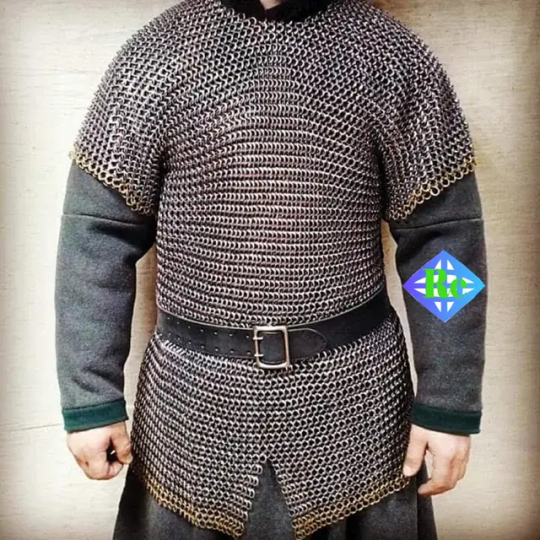

(I like the short sleeve tunic style, and I'm picturing Duke's "White Knight" armor as the basis for the chest piece. I can’t seem to find any laminar reference photos that have that same look; I’m almost picturing a scapular, but made from metal plates.)
The sports boots become combat boots, the knee-pads & bracers get swapped for splint greaves & splint bracers over black leather gloves. The “jewels” are now on the back of the gloves directly, rather than the metal, as the new bracers don’t cover his hands.
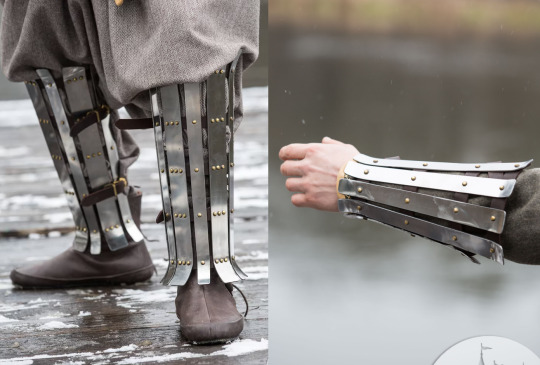
He also adds the Bat ear-points to his helmet, adds a dark undersuit to the top to replace the sleeves, and generally ups the contrast by darkening the greys & either polishing the armor or painting it metallic white (if the latter, the chainmail is probably a light, brassy brown to make them pop.)
(These colors, I believe would depend on the artist; it seems like one of those things people would disagree on.)
All of which helps evolve the look toward the Signal's "motorcycle gear meets knight armor" mash-up.
#reverse!robins#reverse robins#reverse robins AU#reverse order robins#reverse order batkids#reverse batkids#reverse batfam#reverse batfamily#duke thomas#the signal#robin duke#robin duke thomas#robin!duke#robin!duke thomas#the signal dc#batfam#batfamily#bat family#bat fam#batkids#bat kids#bat siblings#batsiblings#my life#mine#//#I don’t love this as much as the Shadow costumes; but then this is one full day’s work rather than a whole week.#Moonbeam’s been giving me trouble since the start so I’m mostly spitballing & rolling with my own design sensibilities as I go here.
39 notes
·
View notes
Text
Florrickology, Part 3: Wyll's Womancrush Wednesday
If Wyllyam Ravengard is gonna do one thing, it's gush about powerful ladies his dad works with big misty heart eyes and his goblet overflowing with Respect Women Juice. While it seems BabyWyll didn't hold a candle for Florrick like he did for Duke Stellmayne, he regards her as a knightly badass to aspire to, just like dear ol' dad.
Thus, when probed about her in Act 2, he delivers the following glowing endorsement... which is also implies some weird things about his (s)hero, when you really think about it.
Player: Can we trust Florrick?
Wyll: I was eleven when the counsellor spotted and slayed an assassin who stalked father from the shadows.
Wyll: I was thirteen when she brought word of a goblin warband advancing on Rivington. Her keen scouting saved a hundred lives that day.
Wyll: The counsellor's loyalty to my father is beyond question. She's as steady as Tyr's heartbeat, as upstanding as the Sword Mountains.
These lines are a prime example of what exactly I meant by 'unintended characterization' in Florrickology Part 1. The point of this conversation is just to confirm that, yes, the player should trust and continue to cooperate with Florrick because her loyalty is well-proven. What Wyll literally says about her isn't important; it's the impression they leave you with that matters.
The writers possibly didn't really mean to imply anything extra with these lines.
But, they did.
What's more, is they seemingly managed to imply two consistent, if odd, things about her.
Wyll, what do you mean she 'spotted and slayed an assassin'?
Wyll, what do you mean 'her keen scouting'?
Both of these are pretty weird things to say about a woman otherwise presented as a urban public servant... but are they weird things to imply about Florrick? Let's dive in.
Side note: it's also funny yet perfectly in character that Wyll looks upon these subtly bonkers accomplishments with such high esteem, since he is also completely insane but manages to maintain a veneer of "the only reasonable person in the room"
In this universe, the threshold for killing people is admittedly pretty low, but the implication that Florrick kills people sounds sort of strange, especially the add-on that she just straight up and killed someone on the streets--no judge or jury, just executioner.
Florrick, a woman presented as a paragon of virtue, whom Wyll promptly then describes as 'upstanding as the Sword Mountains', kills people? And she is a wizard, so she kills people instead of casting any number of incapacitating spells like Sleep, Command, Hold Person, etc?
Yup-- if they're coming after Ulder Fucking Ravengard!
I will have many thoughts about the debacle that is her confrontation in Act 3 in another post, when she believes Wyll sold his father up the river for his freedom, slaps on a fuckass hood, and comes directly for his head, but at least it's consistent with something. She, like Wyll, looks upon Ulder as a hero and the soul of the city she loves and serves so faithfully, and so she, like Wyll, will scuttle all over creation to find him, take on any enemy to save him, and will treat any attempt on him is an attack that must be answered with impunity.
Moving on to the second line, whereas Wyll's other above is echoed in something else that comes up later, Florrick's alleged prowess as a scout is actually mentioned earlier, in Act 1... to a much less frustrating and much more amusing effect:
In Waukeen's Rest, Florrick states "the Duke has been taken westward, if my eyes and ears are to be believed."
By "my eyes and ears", one might assume she means informants... until you remember she's trapped alone and escapes with the player, so there's no way someone debriefed with her during the 15 seconds between busting down the door and this conversation.
So clearly, she was in the burning inn staring through a burning window , mad as fuck, at the drow dragging him away like

tbf "her eyes and ears" could also be people yelling what's going on from the ground while she's trapped upstairs but shhhh this is for fun
While this is again an odd thing to imply about an urban bureaucrat, this one actually makes a lot of sense... because she's a wood elf, a race famously good at scouting the wilderness.
This is slightly debatable because the game randomly doesn't list her subrace and she lacks the Fleet of Foot trait (implying she's a high elf), but I assume her dress is simply so tight and impractical that it nerfs her movement speed. On top of having a distinctive wood skin tone, she's filed under "wood elves" in the list of character models in game files, and if she dies in Waukeen's Rest, you can report finding a dead female wood elf to the Fist and they immediately know it's her. So it seems the intention was for her to be a wood elf, even if they didn't execute it fully.
So, what's strange isn't so much that she possesses this skill, but rather that she deploys it on such a notable basis.
So, unlike Wyll's first line which reinforces something we come to learn later, this line opens opportunities to wonder what we don't know about Florrick.
In the previous installment of Florrickology, I posited she was possibly around 120-130 years old, but Wyll's examples only account for what she was doing 13 and 11 years ago. Other commentary, such as by Ulder, indicates she's been a friend of the family and a public servant for quite some time, but how long? We could have up to 100 years of life to play with. She well could have been wildin' since before Ulder was even born.
Has she always lived in Baldur's Gate? Was she always a government official? Is she even a Flaming Fist (I don't think so tbh, I think she's just understood to be Ulder's stand-in) or was she and if she was, what kind of shit did she get up to? When and how did she meet Ulder? Was she always a wizard (she is only level 6 in Act 1...)? And endless more questions!
The implication seems to be that she's been an advisor as long as Ravengard has been duke, so like... what was she doing out there at all, 11 years ago, discovering goblins far enough away from Rivington that she could intervene and save the whole town? Hiking? Keeping up with her secret ranger multiclass levels? Picking up a patrol shift to stunt on all the humans by having 4 extra hours in the day to spend in service of the city? Visiting her wood elf polycule in the woods and happened across goblin tracks?
For the discerning background character fan, this is a goldmine.
Speaking of headcanons and Wyll, I have also decided that one of his best and funniest ambient dialogues references Florrick, even though it's completely unsubstantiated:
Wyll: When I was a child, father sent me to Sharess' Caress to deliver messages. How was I to know what went on behind its closed doors?
Lae'zel: Eating, sleeping, and sex acts of all manner, of course.
Wyll: Hm. What's plain to you wasn't so plain to mini-Wyll.
Lae'zel: Mini-Lae'zel wasn't so sheltered. On Creche K'liir, very little is hidden behind doors.
We all know Ulder only has one person he'd need to talk to so damn bad that he'd send his son to bother her at the damn brothel!!!
#florrickology#counsellor florrick#bg3 spoilers#bg3#ulder and florrick being codependent besties is real to ME
17 notes
·
View notes
Text
… Eleanor Cobham was a respectable lady who might expect to become a member of the household of a royal woman or member of the upper nobility, before being married and gaining a household of her own. Eleanor’s upbringing was likely to be typical of a woman of her class. She would not have had an exemplary education like Joan of Navarre did, but she does seem to have been taught to read in English, and she may even have learnt to write. Her education would have only been to a level that she would then be capable of running a knightly household and estate once married. The rest of her upbringing would have been focused on feminine values to help attract and keep her a husband, such as singing, dancing, music and needlework.
No known physical description of Eleanor exists, and only one contemporary picture of her survives. This is an illuminated miniature from 1431 of Eleanor with her future husband, Humphrey, Duke of Gloucester, from the Liber Benefactorum of St Albans by Thomas Walsingham. Eleanor and Humphrey were benefactors of the Abbey of St Albans, shown in Humphrey’s hand in the picture, but little of Eleanor’s real physical attributes can be garnered from the picture, it being a typically stylised miniature of the time. Eleanor is shown with a high forehead, the popular style, but her hair is hidden under a covering, so the colour is left a mystery. She is shown as slim and tall, but whether this mirrored her real stature cannot be known for certain. She is wearing a sumptuous red dress with a golden belt, a black head covering with a golden circlet, and a thick golden necklace, representing the wealth of her station as Duchess of Gloucester.
While there is no surviving physical description of Eleanor, it is reasonable to assume that she was an attractive woman. Jehan de Waurin, a Burgundian chronicler and contemporary of Eleanor, describes her as ‘a very noble lady of great descent … also she was beautiful and marvellously kind [pleasant]’. As she was later to attract the attention of a prince, it is likely that she was at least fairly attractive, and probably had sufficient wit and charm to go with it.
Gemma Hollman, "Royal Witches: Witchcraft and the Nobility in Fifteenth Century England"
21 notes
·
View notes
Note
EXPLODES haii may i have prns/titles related 2 bram stoker ^_^

🥀 ⌕ bram stoker themed pronouns 。。。
vamp/vamps/vampself , vampire/vampires/vampireself , fang/fangs/fangself , grey/greys/greyself , gray/grays/grayself , sword/swords/swordself , point/points/pointself , point/pointy/pointyself , scar/scars/scarself , duke/dukes/dukeself , darkness/darknesses/darknesseself , king/kings/kingself , demon/demons/demonself , knight/knights/knightself , mystery/mysteries/mysterieself
🥀 ⌕ bram stoker themed titles 。。。
the vampire , the sword in the stone , the one with pointy fangs , the one who listens to music in great awe , the duke of darkness , the king of demons , the one with knightly scars , the infectious one , (pronoun) who infects others , the mysterious one , (pronoun) who is mysterious

🦇 ⌕ note 。。。 here you go silli :333 i hope you can find smth you like!!

#꒷꒦︶︶ NPTs ︶︶꒷꒦#pronouns#pronoun list#pronoun suggestions#neopronouns#neopronoun list#neopronoun suggestions#titles#title list#title suggestions#bungou stray dogs#bungo stray dogs#bsd#bram stoker#bram
15 notes
·
View notes
Text
Armor: Beyond the Extants
The casual study of armor is dominated by an obsession with the extants, the surviving elements of armor that have been preserved in museums, private collections, and armories or that have been recovered archaeologically. While these pieces remain an invaluable source of information for scholars and laymen alike, there are a great many things they cannot tell us. In order to fill in these gaps in the record, scholars in the study of armor make heavy use of both artistic depictions of armor and the historical record, each of which brings its own advantages and disadvantages. Artwork is a particularly valuable resource, as it allows scholars to see precisely what the artist intended, without the vagaries of interpretation frequently left in the historical record.
There are many disparate kinds of artistic works from the medieval and early modern periods which depict armor and are used by scholars of armor. Here, they will be divided into three broad categories: Paintings, Sculpture, and The Rest.
Paintings
Paintings are among the most commonly utilized and widely recognized forms of medieval artwork. Here, the term “painting” is used in a broad sense; while this category does include the typical paint on canvas framed upon a wall, other varieties of painted works are also included.
Portraits are some of the most instantly recognizable forms of painting. Typically in the traditional form, many wealthy and influential men have had their portraits painted over the years, a tradition that lasts even to this day. The practice of being painted in one’s armor is one that came to be common in the 16th century. The portrait pictured below depicts Alfonso I d’Este, Duke of Ferrara and a commander in the Italian Wars.

The portrait of Alfonso d’Este radiates wealth, power, and military prowess. Trimmed with gold, his armor represents the height of Italian fashion. The golden chain hanging around his neck displays even more wealth, as well as clearly marking him as a military man and a member of the prestigious knightly order of St. Michael. His surcote is made from an expensive blue silk velvet, and his gilded sword suspended by a blue silken sash. In one hand, he wields a gilded mace (a stand-in for the baton of command, a typical symbol of authority at this time), while the other rests upon the muzzle of a cannon. Though his gauntlets are doffed, they are placed prominently on the table before him, and in the background a battle rages.
This portrait speaks to many things which could not otherwise be known. Even had this armor which Alfonso wore survived, the velvet surcote almost certainly would not have. Additionally, many surviving elements of armor have had their decoration fade over time, or be scrubbed clean by modern collectors. The gilding which decorates this armor may also have never been known to us.
Portraits such as this one are invaluable, and extremely reliable, references for the study of any material culture, including armor. Typically, the portrait depicts what the artist had seen, what actually lay before them. They leave little room for misinterpretation. This is in contrast to our second category of painting.
Religious and Historical Paintings were common throughout the medieval period and well into the 16th century. This category generally includes framed paintings, frescoes, and painted altarpieces. While the paintings of this category are extremely prevalent, and common across the entire medieval period, they require a special degree of caution. While many religious paintings depict religious and historical figures in gear contemporary to the time the figure was painted (see below, an altar panel depicting the Saints George and Sebastian painted c. 1507-1510) some artists also made attempts to make their scenes feel more ancient to a medieval audience.

Below is pictured a detail from the Santa Croce altarpiece, painted between 1325 and 1328 by Ugolino di Nerio. This particular panel depicts the betrayal of Judas and the arrest of Jesus by Roman troops. The Romans in question are depicted in a mix of contemporary and fantastical equipment. The feathered frills on the Roman’s arms and skirts (sometimes called pteruges) are indicative of this fantastical style, and the closely-fitted, almost muscular garments the soldiers wear over their bodies are meant to mimic the “heroic” muscled figures of classical sculpture, indicating an ancient scene to the medieval viewer.

The final category of painting which will be discussed here is the Miniature. While miniatures often contain religious or historical imagery, and so are subject to the same needs for caution as listed above, they operate by different enough rules to warrant their own discussion.
Miniatures are a form of marginalia, tiny paintings added into the margins of manuscripts. As such, though they frequently bear incredible levels of detail for such small works of art, they leave much room for error and interpretation. Miniatures are extremely plentiful, and a very popular source for the study of armor, and when utilized with the appropriate degree of caution, they are indispensable.
Perhaps among the most famous manuscript miniatures are those in MS M.638 at the Morgan Library in New York City. Also called the Maciejowski Bible, or the Crusader Bible, MS M.638 was made in Paris in the 1240’s. Filled with remarkable illustrations, this manuscript is an incredible source for all manner of 13th century material culture, but is especially well renowned for its depictions of 13th century knights and men-at-arms.
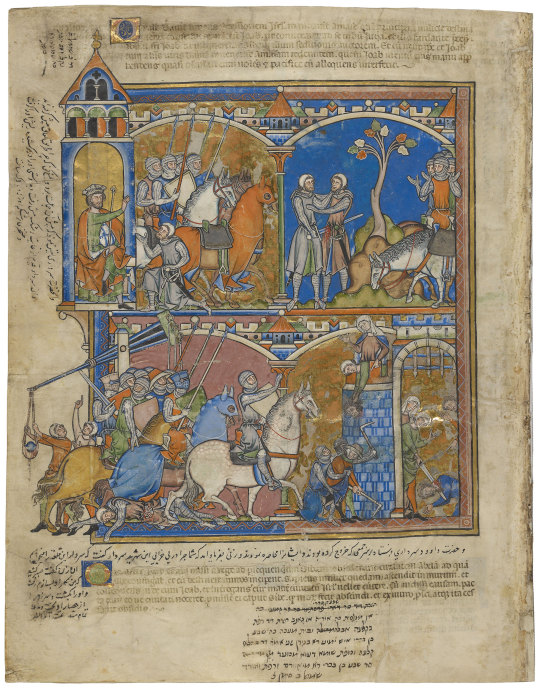
Sculpture
In the category of sculpture, we will first discuss Architectural Sculpture. While with all pieces of art it is best to determine when the individual piece was made, this is particularly true for architectural sculpture. For instance: pictured below is a piece of sculpture off of the Santissima Annuziata in Florence. Though this church was originally built around 1250, it has since been renovated many times. This piece of stonework is not a part of the original structure, but instead was added during one of the renovations. As such, this sculpture does not date to the middle of the 13th century, but instead to the first half of the 14th century, and is representative of military equipment of that time.

The second sculptural category is Effigies. A form of artwork that has seen a recent intensification in use by armor scholars thanks to the Armour of the English Knight series by Dr. Tobias Capwell, effigies (which are typically carved in stone, alabaster, wood, or even bronze) represent a particular individual. Much like portraits, effigies are extremely reliable sources for armor. In his first book, Armour of the English Knight 1400-1450, Dr. Capwell includes an essay defending the accuracy of effigies. He states:
Concepts of purgatory and the way that it worked developed substantially during the twelfth century, with one of the central principles becoming this link between the living and the dead. The living could come to the aid of the dead through intercession- the offering of prayers for the departed soul. As Saul has shown, effigies were intended to work as a kind of intercessionary lens, focusing memories of the deceased and thus facilitating the success of the prayers on their behalf.
As such it was the effigy sculptor's spiritual duty to create a sculpture which was as close to real life as possible, so as to aid the departed soul on its path through purgatory. Frequently, these effigies were even painted. Pictured below is the effigy of Thurstan de Bower at the church of St. John the Baptist in Tideswell, England, dated to 1423.
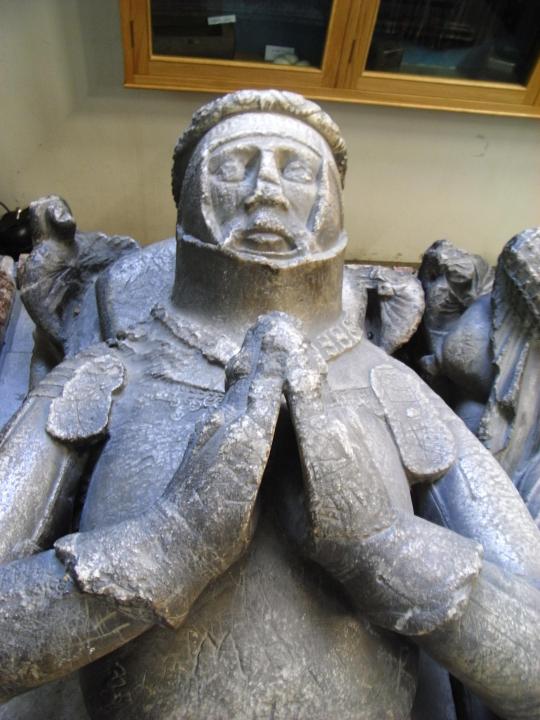
Like other forms of sculpture, however, it pays to know when the effigy was made. In many cases, the effigy was commissioned either before the individual’s death or after by their loved ones. Very rarely does an effigy actually precisely represent the year of the individual’s death, and typically the effigy will present armor contemporary to the time of its manufacture, not the time of the deceased individual’s death.
Many other forms of sculpture persist from the middle ages which occasionally depict martial material culture. Commonly altar pieces carved from wood and alabaster survive, as do statues of saints and other similar sculptural elements. These sculptures follow the same rules as listed above in regards to their usefulness and elements to be weary of.
The Rest
With the primary sources covered, it’s time to move on to The Rest. While the above constitute the most important and most consistently utilized artistic sources for the study of armor, they are by no means the only sources. The armor-clad man-at-arms was central to the image of the ruling medieval class, and as such it suffused every aspect of medieval art. Men-at-arms may be seen in tapestries,

on eating ware,

and even on gaming boards.

What’s important is that, no matter the source, you approach it with a keen, critical eye and that you never stop looking.
234 notes
·
View notes
Text

Some OC art from stream today!! Trying out a new drawing tablet and excited to keep using it :)
3 notes
·
View notes
Text
Morgan’s most spectacular and provocative feat of magic is the Val sans Retour or Val des Faux Amants (the Valley of No Return or Valley of False Lovers), an enchanted valley from which no knight who has ever been unfaithful to his lady in any way, ‘even in desire alone’, can escape, a paradise that rapidly palls on its inhabitants. Here knights are punished for their infidelity; forced to remain in the company of their ladies, they are deprived of the opportunity of performing knightly deeds in an enchantment that lasts seventeen years. [...] It is a comfortable place; the knights can hear mass in a chapel which lies on its borders, for it is secular, not Christian, fidelity that is at stake here. All the trappings of courtly leisure are available: food and drink, backgammon and chess, dancing and music. The knights have the company of their ladies and squires, if these wish to remain with them, and, the text makes clear, the place suited some men very well, ‘many knights … were very much at ease there’.
[...]
The Lancelot follows Galescalain, the Duke of Clarence and Morgan’s nephew, into the Valley in close detail. Though the landscape within may be pleasant, the entrance itself is alarming. Passing through a smoke-like barrier, the duke is constrained on either side by walls so that he cannot turn round. Coming to a low, narrow door he abandons his horse, unsheathes his sword and enters. Within he finds two fire-spewing dragons, which attack, injuring him severely. Passing through a second door he finds a broad, rushing river, which he must cross on an unsteady plank, at the end of which three knights are positioned to attack. At their first onslaught the duke is so terrified that he falls into the river. He is hauled out and beaten over the head until he loses consciousness. Stripped of his armour, he is carried into a garden, where he finds himself in the company of other captive knights and learns the secret of the Valley. Galescalain comments pungently: ‘if he had known no prowess would be of avail, he would never in his life have set foot in that place, for he well knew that no one could love for very long without being unfaithful either in deed or in thought.’ The consequence of his infidelity is the loss of his chivalric attributes: horse, weapons and armour. He is no longer the man he was.
Imprisonment within this female realm thus comes as a consequence of penetration in search of the kind of adventure that should have confirmed Galescalain’s masculinity. It is inviting to read the entrance to the Valley in terms of the female body; once the knight has passed through the hymen-like barrier of the air curtain and is enclosed in the constricting passage there is no going back. After braving the dragons (perhaps the castration fear of the vagina dentata) and his immersion in the river, the cool moisture which medieval physiological theory predicts for the female interior, Galescalain is battered into submission and loses consciousness – the little death of orgasm. Although the Valley challenged his masculinity, daring him to penetrate the adventure, now that he is trapped in its feminized space, his masculine honour is bound to decline. The captive knights must now keep company with women, accommodating themselves to what women want, rather than performing the feats of courage and exercising the freedom to roam which defines the knightly existence.
[...]
As I have suggested elsewhere, the comfortable environment of the Valley, which suits some of its male inhabitants very well, is stigmatized partly because it offers real attractions. Being a knight-errant is hard work: in Erec when Enide accompanies her husband on the journey in which his reputation is restored, she witnesses the physical discomforts and the exhausting imperative to fight all challengers even when injured that the knight has to face. In the twelfth century, as noted in Chapter 2, a new understanding emerged that marriage could produce happiness and intimacy for the couple, rather than simply resulting in an alliance for breeding heirs. Thus fighting men might have a strong need for family and home. The treatment of the Val sans Retour is partly determined by the realization that the family environment is a less stressful alternative to the anxieties involved in performance at court and in battle. Knights needed to be reminded that while a retreat to the domestic and feminine for recuperation is permissible in the short term, the real action lies elsewhere in the courtly universe.
— King Arthur's Enchantresses: Morgan and Her Sisters in Arthurian Tradition by Carolyne Larrington
#arthuriana#arthurian legends#morgan le fay#the duke of clarence#talk talk talk#gella talks arthuriana#currently reading#dracula academia made me allergic to penetration metaphors but i still found this one paragraph interesting
7 notes
·
View notes
Text
Top 9 Books*
*I read way too much for this game so instead I'm going with "Top 9 historical romances read for the first time in 2023, no more than one per author and series (with exceptions for honorable mentions)"
Tagged by @tripleaxeldiaz (MWAH) [I don't think this tag game was necessarily intended to be a rec list but here we are - under a cut for length]
The Duke Gets Even by Joanna Shupe
Summary: To escape the shackles of marriage, Nellie Young purposely ruined her reputation a long time ago. Now she dedicates herself to hedonistic pleasures only, like kissing a handsome stranger in the ocean under the moonlight...
To save his estate, the proper Duke of Lockwood must marry the perfect bride—wealthy, with an unblemished reputation. While in New York he's the perfect gentleman, and no one knows he's suppressing his darkest desires. The last thing he needs is another scandal.
Except Nellie sees through Lockwood's charade, straight to the real man underneath. This uptight duke is far more than he lets on, and she can't resist him. Their secret affair turns scorching, far more than either expected. And when his beautiful rebel finds an unconventional cause, Lockwood has to decide if he's willing to sacrifice everything to keep her.
Thoughts: Joanna Shupe really saved the best for last to wrap up her Fifth Avenue Rebels series. There is so much that’s so good, not the least of which is that the tension is immaculate after three books of these two sniping at each other from the sidelines. And when it finally snaps, it’s so satisfying. Also, I have a great appreciation for romances where the stakes feel real and relatable and the obstacles aren’t contrived or easily swept aside and I felt that was true here.
A Convergence of Desire by Felicity Niven
Summary: An insatiable rake falls for an eccentric genius. Too bad she's his innocent bride, and he has vowed never to touch her.
Harriet “Harry” Lovelock lives a life of the mind, and she knows she can prove a theorem that has baffled male mathematicians for two centuries. But her stepmother wants her married and the swirl of the Season saps Harry’s energy and distracts her from her work. She has to put an end to the tedium of balls. Now. Full stop.
Thomas Drake, the Earl Drake, devotes himself to the pleasures of the flesh, even as he wrestles with his own demons and intractable problems. He needs to marry wealth, but could he ever be satisfied by just one woman?
She can spend all her time on her proof. He can have any woman he wants, except her.
Their marriage of convenience could prove to be the perfect partnership—as long as love never enters the equation.
Thoughts: a new author for me, and wow oh wow. First of all, the heroine—I feel like far too often in HR when an author says they’re writing a neurodivergent heroine what ends up on the page is just sort of shades of smart and quirky (maybe with a side of shy or anxious). That is not the case here. Harry is full out Beautiful Mind, doesn’t sleep, doesn’t eat, doesn’t particularly like or understand most people and can be unintentionally cruel at times as a result, finds most facets of generally being alive incredibly inconvenient because they get in the way of her math—and the author doesn’t try to shy away from that. She is messy, she is flawed, she is abrupt and not the most likable at times, and that’s not only okay, it’s the whole point! And Thomas, oh my god, watching him be like “my wife is encouraging me to be unfaithful and leave her alone, this should be the perfect arrangement…except that somehow all I want is to listen to her talk about math and make sure she’s eating and getting enough sleep and actually I don’t want to be with any other women oh hell” is a truly delightful journey. Reader: I cried. I loved it so much.
The Notorious Lord Knightly by Lorraine Heath
Summary: A scandalous book by an anonymous author takes London by storm, and everyone is convinced its villainous “Lord K” is the greatly admired Earl of Knightly. Heartbroken that he left her at the altar, Miss Regina Leyland impulsively sought revenge by revealing the true Knightly to the world but never expected the uproar to bring enemies to her door. To keep her identity hidden, she must trust the one man with the power to destroy her.
Furious to be the object of notoriety and gossip, Knightly confronts the lady he suspects of penning the tome only to discover she is no longer the naïve innocent he was forced to betray, but a woman of strength and conviction, who will bow before no man.
Knightly and Regina pretend a reconciliation to salvage their reputations and throw the ton off their scent. But false friendship soon turns to powerful passion. When truths emerge, threatening all they hold dear, they must face the consequences of their past if their story is ever to deserve its happily ever after.
Thoughts: Lorraine Heath is one of those authors who is truly in a class of her own (which is excellent because she’s been writing forever so her backlist is a million miles long) and this was no exception. I’ll be honest—I love a second chance romance. But only when done well. And it is way easier to write really mediocre second chance romance than put in the work—a lot of the time I feel like either the original stakes are lacking (so that it’s like “really? This was why y’all couldn’t get your shit together the first time and/or you held a grudge for so long over that?”) or very overblown (so it’s “wow yeah that was genuinely super shitty and the justification sucks, get some self respect you don’t have to forgive that”). But this was such a good example of second chance done right. The stakes made sense, the emotions were valid, the journey felt justified, the payoff felt earned…ugh, yes, so good.
The Secret Lives of Country Gentlemen by KJ Charles
Summary: Abandoned by his father, Gareth Inglis grew up lonely, prickly, and well-used to disappointment. Still, he longs for a connection. When he meets a charming stranger, he falls head over heels—until everything goes wrong and he's left alone again. Then Gareth's father dies, turning the shabby London clerk into Sir Gareth, with a grand house on the remote Romney Marsh and a family he doesn't know.
The Marsh is another world, a strange, empty place notorious for its ruthless gangs of smugglers. And one of them is dangerously familiar...
Joss Doomsday has run the Doomsday smuggling clan since he was a boy. When the new baronet—his old lover—agrees to testify against Joss's sister, Joss acts fast to stop him. Their reunion is anything but happy, yet after the dust settles, neither can stay away. Soon, all Joss and Gareth want is the chance to be together. But the bleak, bare Marsh holds deadly secrets. And when Gareth finds himself threatened from every side, the gentleman and the smuggler must trust one another not just with their hearts, but with their lives.
Thoughts: QUEER HR MY BELOVED. KJ Charles’ books always have such a great Energy, I can’t even explain it, but this opener to a new series has so much good stuff. It’s got smugglers, it’s got family drama, it’s got murder and intrigue and disaster queer boys (who can occasionally be extremely competent), it’s got political and social commentary, it is, frankly, just a damn good time. (The second book in the series just came out and I am very impatiently awaiting my turn on the hold list at the library). Just read it.
Always Be My Duchess by Amalie Howard
Summary: Lord Lysander Blackstone, the stern Duke of Montcroix, has only one interest: increasing his considerable fortune. After a series of betrayals, he keeps his emotions buried deep. Money, after all, can't break a man's heart—or make promises it can’t keep. But when his reputation for being heartless jeopardizes a new business deal, he finds himself seeking a most unusual—and alluring—solution . . .
Once an up-and-coming ballerina, Miss Geneviève Valery is now hopelessly out of work. After refusing to become a wealthy patron's mistress, Nève was promptly shown the door to the streets. When she accidentally saves the life of a handsome duke, she doubts the encounter will go any better than her last brush with nobility. But instead of propositioning her, Montcroix makes Nève an offer she would be a fool to refuse: act as his fake fiancée in exchange for fortune enough to start over.
Only neither is prepared when very real feelings begin to grow between them. They both stand to win . . . but only if they’re willing to risk their hearts.
Thoughts: Amalie Howard is one of the authors I read for the first time this year where I devoured her books like candy in far too short a period of time and was then left metaphorically turning the bag upside down and shaking it while pouting and wondering why there wasn’t more. Because of that (and the fact that choosing just one was incredibly difficult), she gets an extra honorable mention title. Always Be My Duchess though was a really lovely take on basically “Pretty Woman but make it HR” (she has several books clearly inspired by 90s romcoms that are very well done) and it got me big in my feelings.
*Runner Up/Honorable Mention: The Princess Stakes
Duke of My Heart by Kelly Bowen
Summary: Captain Maximus Harcourt, the unconventional tenth Duke of Alderidge, can deal with tropical storms, raging seas, and the fiercest of pirates. But he's returned home from his latest voyage to find a naked earl - quite inconveniently deceased - tied to his missing sister's bed. And he has only one place to turn. Now he's at the mercy of the captivating Miss Ivory Moore of Chegarre & Associates, known throughout London for smoothing over the most dire of scandals.
Miss Moore treats the crisis as though it were no more serious than a cup of spilt tea on an expensive rug. As though this sort of thing happened on the job every day. Max has never in all his life met a woman with such nerve. Her dark eyes are too wide, her mouth is too full, her cheekbones too sharp. Yet together, she's somehow...flawless. It's just like his love for her, imperfect, unexpected - yet absolutely true.
Thoughts: what can I say, I love a romance with a detective story and this heroine is basically a HR Olivia Pope. I love her, I love Max, really I loved this whole series—so much fun.
The Perks of Loving a Wallflower by Erica Ridley
Summary: As a master of disguise, Thomasina Wynchester can be a polite young lady—or a bawdy old man. She’ll do whatever it takes to solve the cases her family takes on. But when Tommy’s beautiful new client turns out to be the highborn lady she’s secretly smitten with, more than her mission is at stake . . .
Bluestocking Miss Philippa York doesn’t believe in love. Her heart didn’t pitter-patter when she was betrothed to a duke, nor did it break when he married someone else. All Philippa desires is to decode a centuries-old manuscript to keep a modern-day villain from claiming credit for work that wasn’t his. She hates that she needs a man’s help to do it—so she’s delighted to discover the clever, charming baron at her side is in fact a woman. But as she and Tommy grow closer and the stakes of their discovery higher, more than just their hearts are at risk.
Thoughts: QUEER HR MY BELOVED, ELECTRIC BOOGALOO SAPPHIC EDITION. God. GOD. This book…it’s so MUCH. There’s so much of this whole series that’s very fun and lighthearted but then unexpectedly you’ll be punched in the gut with emotions, and there were definitely moments in this one that ripped me to shreds in the best way (and then gently put me back together again). You will laugh, you will cry (I certainly did), you may very well cheer, and the HEA here was everything my queer ass ever wanted.
Her Wanton Wager by Grace Callaway
Summary: A Wager She Can't Afford to Lose
When her brother falls into the clutches of gamester Gavin Hunt, feisty heiress Persephone Fines will do whatever it takes to save him. Hunt offers her an outrageous proposition: he will release her brother… if she can resist six nights of seduction. Can she withstand the scoundrel's wicked charm—and the shocking desire he rouses with each touch?
A Bet He's Determined to Win
A product of London’s violent stews, Gavin Hunt has clawed his way to success and power. Now he will stop at nothing to achieve his life-long goal: revenge upon the man who betrayed him. He plans to seduce his enemy’s sister… but doesn't count on losing his heart. Will he give up his need for vengeance—or risk forsaking the only woman he’s ever loved?
From Six Nights to Forever
As the battle of the sexes rages on and seduction flares into uncontrollable passion, Gavin and Percy must also fight a hidden enemy. Only by trusting one another can they defeat the threats of past and present. In this high-stakes game of love versus sin, what will be the outcome of… Her Wanton Wager?
Thoughts: OKAY LOOK. Grace Callaway is another author in the category of “I read her for the first time and within like two weeks I had read everything and was screaming crying desperate for more because she’s SO GOOD.” So she gets one spotlight and then honorable mentions from each separate series because all of her books are so good. I think I had to go with this one (despite the very fierce competition) because at the end of the day Iiiiiiiii am a huge slut for a “dark and twisty criminal hellbent on revenge and the lady who may become the light of his life but will also take no shit” story ESPECIALLY if it involves scandalous (consensual) bets over sexual favors. And this one fucks (pun absolutely intended).
*Runner Ups/Honorable Mentions: The Duke Who Knew Too Much (from the Heart of Enquiry series—spinster debutante catches kinky duke engaged in certain Activities and wildly misconstrues the situation, when his lover turns up dead and he’s framed for the murder, she tells the police that he totally must have done it because of the aforementioned kink that she wildly misconstrued, he takes her to a sex club to be like “FFS I’M NOT A MURDERER I’M A DOM” and she feels so guilty that she insists on helping him clear his name. COMEDY); The Duke Identity (Game of Dukes series—policeman and disgraced scientist/inventor goes undercover to become the bodyguard to the granddaughter of the criminal underworld’s most notorious kingpin, a woman who definitely does not want a bodyguard, and they have to ultimately work together to save the day when something turns out to be rotten in the state of Denmark); Fiona and the Enigmatic Earl (Society of Angels series—oh my god you guys it’s HR Charlie’s Angels and it’s the BEST. This particular one is debutante who is secretly a detective solving crimes for women needs to get married so she can get out from under her family’s thumb and have some independence to continue being a detective, enters into a marriage of convenience with a man who is secretly an agent for the Crown, both of them fully intend to just keep lying to each other until their separate investigations turn out to be linked…literally every book in this series is a Delight).
Knockout by Sarah MacLean
Summary: With her headful of wild curls and wilder ideas and an unabashed love of experiments and explosives, society has labeled Lady Imogen Loveless peculiar…and doesn’t know she’s one of the Hell’s Belles—a group of vigilantes operating outside the notice of most of London.
Thomas Peck is not most of London. The brilliant detective fought his way off the streets and into a promising career through sheer force of will and a keen ability to see things others miss, like the fact that Imogen isn’t peculiar…she’s pandemonium. If you ask him, she requires a keeper. When her powerful family discovers her late-night activities, they couldn’t agree more…and they know just the man for the task.
Thomas wants nothing to do with guarding Imogen. He is a grown man with a proper job and no time for the lady’s incendiary chaos, no matter how lushly it is packaged. But some assignments are too explosive to pass up, and the gruff detective is soon caught up in Imogen’s world, full of her bold smiles and burning secrets…and a fiery passion that threatens to consume them both.
Thoughts: LMAO y'all had to know this list wasn't ending without some Sarah MacLean. Anyway, 12/10 no notes, I waited two years for this book knowing it was going to give Everything because the moment these two were introduced back in Bombshell I was obsessed (I mean, who DOESN'T love a girl who likes to blow things up and flirt shamelessly with entirely too honorable policemen who are at their wits end?). As always, thank you Ms. McLean for my life.
12 notes
·
View notes
Note
I am lowkey highkey obsessed with Thomas. He comes across as having a streak of earnestness in some things I read (it was either his knightly brotherhood agreement with Charles Duke of Orleans or his letter to Henry about how awful his situation in Ireland was) but I also like the hotheaded, reckless image of him. I think a lot of modern historians either overlook him because he wasn't around for Henry VI's minority or just tend to assume that the Battle of Bauge tells us everything about his personality and thus we end up at the hotheaded, reckless idiot image.
(also re: Henry; I think CGW says something like he could have been a good king but the way he became king meant he could never be a good king because usurpation left too great a stain on his character. That makes a lot of sense to me. Plus he got so sick just as he was starting to gain stability on the throne… you can almost sort of read this trend of Henry being like "time for kingly awesomeness! (a fun party ala Edward III; going on a military campaign)" and then ending up having another rebellion or health crisis. The dickhead was still doing it up to 1412 - he was going to lead Thomas's expedition! Until he couldn't…)
(I have written and re-written this so many times to try and clearly explain my view and I'm still not happy with it v.v)
I kind of like the mental image of Thomas as a hot head, but a hot head with a heart of gold iykwim. It really annoys me that we don't know more about him, because reading about his stint in Ireland and campaign in France knowing how much people wanted him to be heir instead of Hal really just... baffled me. The failure of those two things don't exclusively or even predominately fall on his head, it just doesn't explain why people were so ready to back him over Hal, who already had a quashed rebellion under his belt (it'd be easy to brush it off as just people really hating Hal, which they did seem to, but they also seemed to genuinely want Thomas). I think it mostly comes down to Thomas' strengths being in areas that weren't necessarily conducive to leading a country, the way Hal, John, and likely Philippa's were, but we only know of those strengths because we have been able to evaluate their and their successors achievements to examine what does make a good monarch.
CGW coming to that conclusion about Henry IV didn't make a lot of sense to me, because that book did a really good job at detailing all the ways Henry was ill-equipped to be king ^.^'''' A lot of it was definitely because of him being a usurper, like being unable to convince parliament to raise taxes because they would leverage his own promises against him, or his habit of basically never standing up for himself and then going too far in the other direction, realising how much he screwed up, and then swinging too far back again (see the Scrope debacle). And even without all the ways his being a usurper affected him, there are so many instances of him straining against the monetary confines he now has to live with (I understand why he wanted the Duchy of Lancaster to be kept separate from the crown. Terrible outcome, but understandable), or wanting to be on crusade and not being able to because he is king, or the trouble he went through for marrying Joanna because it wasn't a good marriage for a king... all of it very much suggests to me that again, the 'princely virtues' he was so often praised for over Richard did nothing to actually prepare him for running a government, and there is a lot that suggests to me he didn't enjoy it. I guess you give him more credit that I do
30 notes
·
View notes
Text
Gerudian Dashboard Simulator 2

🍷 WhinewithWine Follow
Capitan Marcus Graphitter, Mariott's head crime syndicate boss who co-opertaes with the city guard, is a nasty little thottie and just died making it clap in his own tavern

🖼 Grandiose-Aesthetic Follow

#Lascue #Knightly Adventure #Enchanting #Northwestern Vale #Breathtaking

🖋 Coralines-shameless-smut-blog Follow
Ser Sean Mar y Lyonel de Lazure x !Arranged Bethrothed Reader Imagines
Keep reading
🦐Drunken Treasure Follow
gurll this is nottt the time he was just declared missing two days ago

🎻He/Hymn Follow
So like are we *totally* sure that Duke Berdrick isn't a lich? Because like. Have y'all seen him?
💎Revivify Follow
The Duchy Necromancer when you ask him why he has to spend a minute with Berdick alone once every 8 hours


💃Eladrinking Follow
Leaving the function almost immediately after entering. call that Huanthing
🧙♀️Fagisterium-Ofiicial
Wait I gotta cast legend lore
🧙♀️Fagisterium-Official
Okay yeah this is funny

🔪Butcher-than-a-butcher
I think that not having a courtyard to dunk on some barons during balls is false advertising, and should be illegal

🏹MILFs-top-Milf Follow
So i'm on my watch as a city guard, yeah? And we've been hosting mercenaries for the past two months, so it's been hectic, i've seen some shit, don't get me wrong, but this is beyond even me. I'm on street patrol on Smith's Bend, and i see this gagglefuck cluster of adventurers just like? Enter the sewer that were pointed out by a child or perhaps a gnome. And lemme tell you. They looked like professionals. I'm talking like plate armor and magic items. So protocol dictates that i observe and not intervene, because I don't want to get my rectum mangled by some jackass wizard's spell. So they enter, sure, why not, and I decide to move along on patrol, which takes me the better part of two hours, and as I go back there, there they are? BUt they're covered in some strange viscera, and one of them is like fucking caked in blood and mucus, and weirdest part is that one of them is missing??. Anyway they don't pay me enough to bother adventurers, but like what? Girl help
🏰Marthot




the tags on this post are killing me sksjhsjaj
🐉Tiamats-head-game Follow
hey would that not be the guys who felled the sewer hydra
🐄Cowmomma Follow
Yes! They are called The Songbird Brigade, and they were also present at the Lazuli Palace Gala recently. they seem to be closely associated with both Lord Commander Creagan and Jacynthia's bethrothed, Krugan. Supposedly, they were also present at the great knighting of Ashenaide crisis
🎇Beric-the-Cleric Follow
So what happened to the last guy? Wouldn't they at least recover his corpse?
😈Thiefling Follow
maybe the sewers orcs got him?
🎇Beric-the-Cleric Follow
the what?
🐈Nekomancer Follow

🧙♂️BlizzardWizzard Follow
Hey guys they're actually called the Nightingale Company
⚔MILFs-top-Milf Follow
what happened to my post

🐐GOAT-knight Follow
Wake the fuck up sheeple. New archeological dig reveals the remenants of a long forgotten civilization from before the giants, along with what seems like an attempt to create an artificial god
✨Blame-Shift
and Marcianno Kordessa's third volume of Encyclopedia Geneticae STILL isn't out
#unproductivity king #go girlie give us nothing 💪

🌹Maidone
Need me nepo-dick from a cringefail Ashenaidean knight

🐙Blundersea Follow
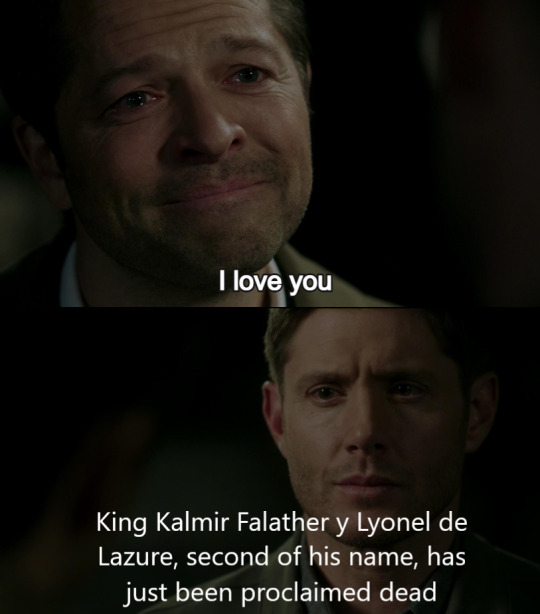
🦈Elf-on-the-shelf
🦀🦀🦀🦀🦀🦀🦀🦀🦀🦀🦀🦀🦀
🐙Blundersea Follow
kys knife-ears

again. campaign meme. don't worry everybody
@zoomire @no-comment-data-missing
3 notes
·
View notes
Text
Anyways here are my top 5 historicals:
Devil in Winter by Lisa Kleypas
Duke of Midnight by Elizabeth Hoyt
The Duke Gets Even by Joanna Shupe
The Notorious Lord Knightly by Lorraine Heath
Any Duchess Will Do by Tessa Dare
Some of these have problematique plots and sex scenes but like, anything that involves statutory rape is much, much worse.
2 notes
·
View notes